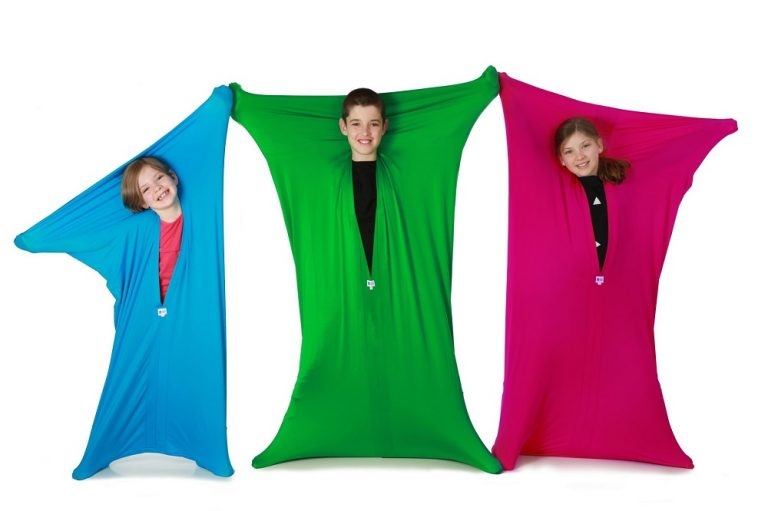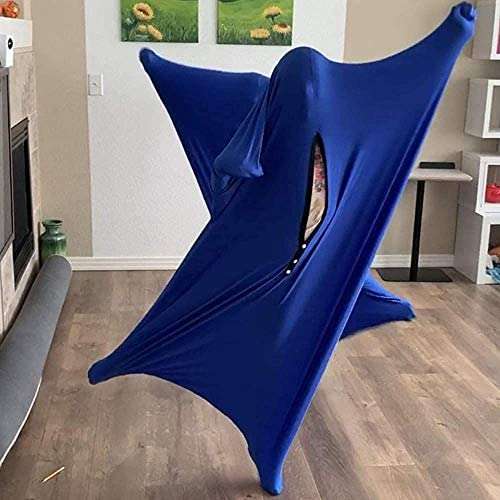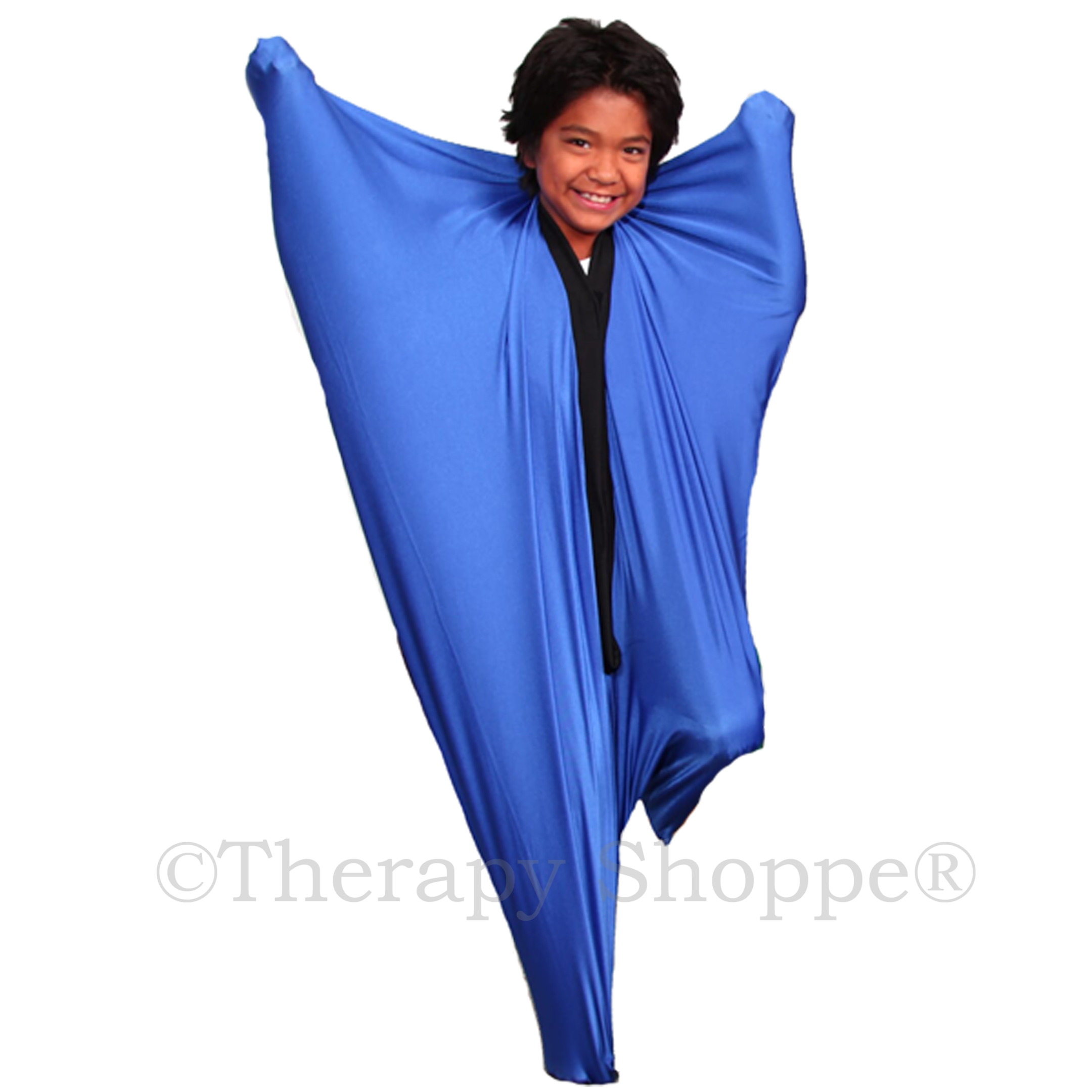
Have a kid that’s always bouncing off the walls? Do they love to crash into everything? Do you wish your child had an easier time relaxing? Then, a sensory body sock might be a great sensory activity to calm your child.
What Is a Body Sock?

A body sock is a sensory tool or toy that looks like an enormous pillowcase, but the opening to the pillowcase has a slit in the middle and the fabric is stretchy. Body socks were designed for a child to climb inside of and stretch out the arms and legs, in doing so the fabric provides a lot of resistance.
The Body Sock is designed with autism and sensory issues in mind. Your child will love to play, stretch, or relax in our sensory sock! It also gives the tactile benefit for seekers because it is soft and stretchy to the touch. The body sock provides calming and organizing input all over the body at the same time.
Why Are Body Socks Beneficial for Kids?

Sensory Input
The resistance created by the snug fabric provides vestibular input and proprioceptive input. In simple terms, this is an awareness of our body in space – its movement, balance, and coordination.
This deep pressure input from the sock helps calm the sensory systems and helps to prevent sensory meltdown.
Proprioception is one of our 8 senses that has receptors all throughout our joints and muscles. Those receptors send signals to the brain anytime they’re squeezed or activated through pressure. Many kids that are sensory seekers love proprioceptive input which they get when they climb, jump, run, squeeze into a tight space, or hug somebody.
The sensory body sock is a direct way to provide that proprioceptive input that seekers crave.
Some kids that seek proprioceptive input don’t seem to process it well. The reason we have a proprioceptive sense is to give us body awareness. Body awareness is understanding where our arm or leg is without having to look. It allows us to walk across a room full of furniture and not bump into anything.
If a child doesn’t have a good sense of body awareness, they’re often described as clumsy. A sensory body sock heightens the proprioceptive feedback and may help them improve their sense of body awareness and spatial awareness as well!
Motor Skills
Body socks are fantastic for motor planning skills development as your child explores different movements with their arms, legs, and core.
When to Use a Sensory Body Sock with Your Child
Sensory body socks can be used at various intervals throughout the day. Ideally, your child has access to it and and can use it whenever they want. However, you may also want to consider when your child is struggling to sit still or seems to be seeking that proprioceptive input, and offering it then, which is the essence of a sensory diet.
If your child struggles in school with hyperactivity, then give them 10 minutes to use the body sock before school. Or, are they a bundle of energy when they get home? Give it to them after school.
Check with your child’s teacher if you think your child would benefit from using a sensory body sock at school as well. It could be a great way to incorporate a movement break. Body socks fold up easily and can fit in most backpacks.
They also help some kids calm down for sleep at night, so using one as part of your bedtime routine might also be helpful.
Body Sock Sensory Activities for Kids
Body socks are incredibly versatile and can be both calming or stimulating, depending on how you use them.

Let your kids’ imaginations run free to create their own play ideas, or try some of these body sock activities:
1. Gross Motor Play
Movement play is so exciting inside a sensory sock! Create challenges that invite your child to move their head, arms, and legs in interesting ways.
One creative way to do this is playing the classic children’s game ‘Simon Says’ inside the sock. You could also ask them to mirror your movements or see how many different ways they can find to move across the room in the sock.
2. Obstacle Course
To add an extra element of gross motor challenge, set up obstacles for your child to navigate while wearing the sock. This is perfect for practicing whole-body movements such as climbing, rolling, and balancing.
3. Reading Den
Body socks are calming and reduce sensory overload. Make it a regular feature of quiet time or use it for story time. You could fill the sack with stuffed animals or blankets to make it extra cozy.
4. Yoga or Dance
Stretch and balance with some yoga poses such as downward dog or tree pose or get groovy and throw a sock dance party for some guaranteed giggles.
5. Break Tool
A sensory body sock can provide a welcome break following a tiring or over-stimulating activity. If you have a sensory room or quiet space in your home, try adding a body sock as another tool your child can use to help them to soothe and regulate. One of our friends even enjoys a relaxing swing while in his body sock!
6. Play!
Play in the sock with your child’s interests and ideas in mind.
Do they love dinosaurs? Try dinosaur role-play and fly like a pterodactyl!
Do they prefer quiet games? Have your child lay on the floor cocooned in the sensory sock to complete a puzzle.
The options are limitless here. Play tug, combine it with time on a sensory swing, try hide and seek, or any other games your imagination can think of!
Choosing the Right Body Sock for Your Child

There are many different options you can choose from when choosing a sensory body sock. You’ll need to consider the following when deciding which is right for your child:
Age and height of your child
Some manufacturers organize their products by intended age. This can give you a general idea, but most importantly, you want to make sure the length is right for your child’s height.
The body sock should be near to your child’s height or a little smaller to give the correct level of resistance.
Material of body sock
Lycra is often the chosen material for a sensory body sock. Others use spandex, polyester, or a mixed fabric blend. Children have different sensory preferences and it’s important to choose a material that they find comfortable. If you’re not sure which material would be best for your child’s needs, consider asking their occupational therapist.
Closures
Most body socks use velcro to close the opening, which can be easier for your child to independently open and close. If your child finds velcro too scratchy, you may want to pick a sensory sack with snap or zipper closures.
What do I need to know when I’m using a Body Sock?

When we are providing opportunity for children to go ‘inside’ something, we need to make sure that the ‘outside’ is safe. This means;
-
Physically safe – no sharp edges, nothing they might stand on, or bang into, or damage – so they don’t hurt themselves or anyone else, or feel embarrassed if they do bang into something
-
Emotionally safe – this means that a Key Adult is available to make sure they have everything they need. This might include making sure other children or adults nearby are kept at a safe distance, that no one comes into or leaves the room without the child knowing, no one touches them unexpectedly, and that they can get out when they need to. To climb into something (especially when your vision is occluded!) can make you very emotionally vulnerable, so it is really important to make sure you’ve thought about all of these things in advance.
-
Your child might like to position themselves ‘backwards’ – so the opening is behind them. Others might like to stand in it ‘forwards’ – possibly even with their head sticking out. Whichever way they go for is fine, and will help them to feel safe.
Don’t ever ‘cajole’ someone into going into a body sock – if their body is not organized, they might not feel safe – and might even feel trapped. Timing is really important with play – using games and toys at times when it feels right for the child.
Essentially, having fun is the main component for ANY play to be organizing and regulating. Explore, experiment – enjoy!










1 comment
Is there a catalog to order from for enrichment tools for autistic children to benefit .also teaching methods to assist with writing reading and arithmetic.439 e. Oklahoma pl.tilsa Oklahoma 74106.
Leave a comment